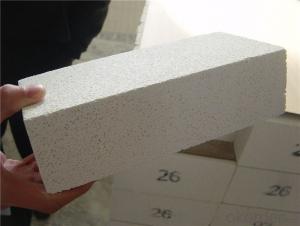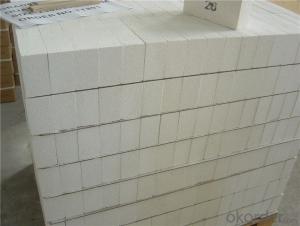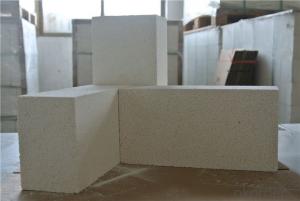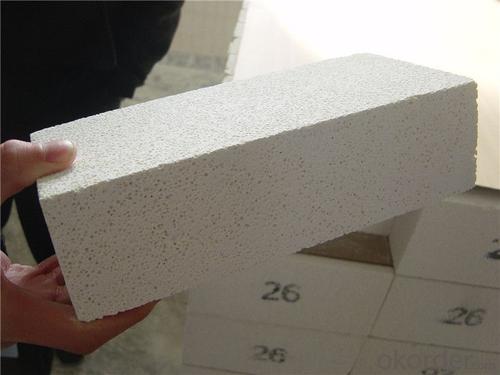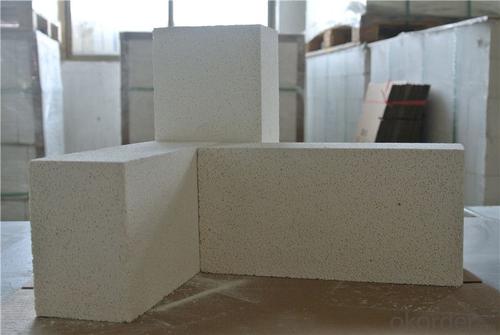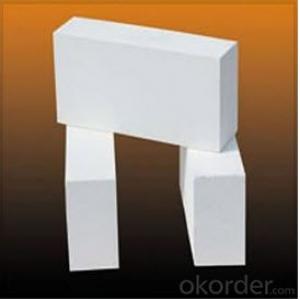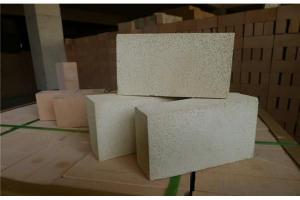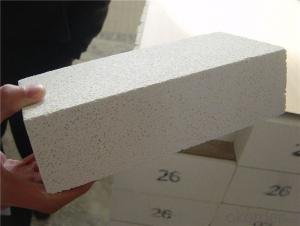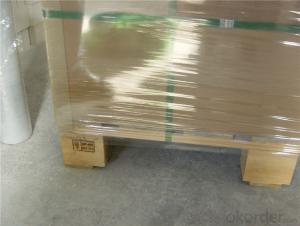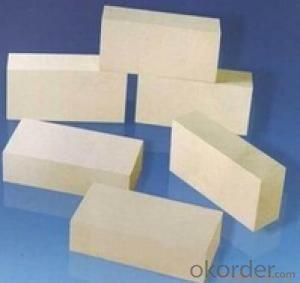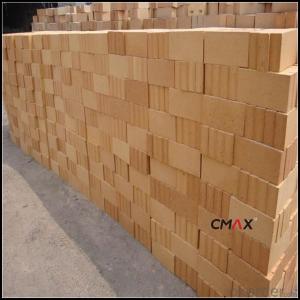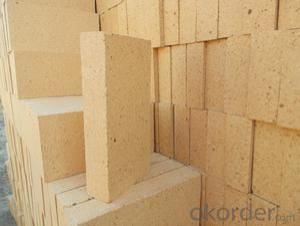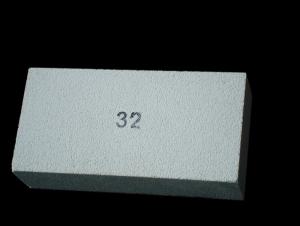Insulating Fire Brick - Lightweight Fire Clay Insulating Fire Brick
- Loading Port:
- Tianjin
- Payment Terms:
- TT OR LC
- Min Order Qty:
- 30 m.t.
- Supply Capability:
- 10000 m.t./month
OKorder Service Pledge
OKorder Financial Service
You Might Also Like
CNBM conforms strictly to the requirements of ISO 9000 quality control system during the production. MSDS is also available if you want. The thermal insulation fire clay brick meet with the requirements of ASTM & JIS standards. So pls stay cool with our quality.
Insulating Fire Brick Technical index
Product No. | IFB70 | IFB60 | IFB50 | IFB40 |
Al2O3 | 68%-72% | 58%-62% | 48%-52% | 38%-40% |
Refractoriness (°C ) | ≥1790 | ≥1790 | ≥1790 | ≥1790 |
Bulk density (g/cm3) | 2.50-2.60 | 2.35-2.45 | 2.20-2.30 | 2.10-2.20 |
Apparent porosity (%) | 22 | 19-22 | 17-20 | 17-20 |
Cold Crushing strength (kg) | 480-510 | 450-480 | 430-450 | 390-430 |
Application
Insulating Fire Brick are used for the lining of converter, alternating current arc furnace, direct Current arc furnace and the ladle slag line, etc.
Equipment
1 unit of Ceramic Abrasive (SG Abrasive) pilot production line
2 units of Compact grain Abrasive pilot production lines
1 unit of high-end coated abrasives (abrasive cloth) production line
2 units of Boron Carbide production lines
3 large flexible crushing and sieving lines for grit production lines
2 units of 2000KVA furnaces for Boron Carbide fusion
6 units of 5000KVA-10000KVA dumping type electric arc furnaces for Brown Fused Alumina fusion
Company Advantage
(1)Long Insulating Fire Brick manufacture history: 25 years manufacturer
(2)Advanced equipment
(3)Diversification of production standards: ISO ANSI FEPA JIS ASTM
(4)Flexible payment: T/T L/C D/P D/A
(5)Professional marketing team and after-sale service
(6)Free sample
FAQs
Q1 |
What’s the transport method? |
A1 | FCL delivery goods with wooden pallet or wooden case by sea; If LCL delivery, must with wooden case; Sometimes need open top, flat rack or bulk cargo. |
Q2 |
What’s the required payment term? |
A2 | Generally 30% TT as the prepayment, 70% TT before delivery. If need, 100% Irrevocable Letter of Credit or negotiation. |
Q3 |
Which country are our products exported to? |
A3 | Apart from entire Chinese market, the US, Russia, Japan, Korea, Australia and some Southeast Asian Nations. |
- Q: Can insulating fire bricks be used in ceramic industry kilns?
- Yes, insulating fire bricks can be used in ceramic industry kilns. These bricks are designed to withstand high temperatures and provide excellent insulation, making them suitable for use in kilns where high heat retention and energy efficiency are important.
- Q: Are insulating fire bricks resistant to moisture or water damage?
- Insulating fire bricks are generally resistant to moisture or water damage. These bricks are designed to have low porosity and high density, which helps prevent water absorption. Additionally, they are typically made from materials like alumina or silica, which have inherent resistance to moisture. However, it is important to note that no material is completely impervious to water, and prolonged exposure to moisture or water can still have some effect on the insulating fire bricks over time. Therefore, it is recommended to take necessary precautions, such as applying appropriate sealants or coatings, to enhance their resistance to moisture or water damage in certain applications.
- Q: Can insulating fire bricks be used in reheating furnaces?
- Yes, insulating fire bricks can be used in reheating furnaces. They are designed to withstand high temperatures and provide excellent insulation, making them suitable for use in heating and reheating applications.
- Q: Can insulating fire bricks be used as a lining for boilers?
- Yes, insulating fire bricks can be used as a lining for boilers. Insulating fire bricks are designed to withstand high temperatures and have excellent thermal insulation properties. They are commonly used in applications where heat retention and energy efficiency are important, such as in industrial boilers. The insulating properties of these bricks help to reduce heat loss and increase the efficiency of the boiler. Additionally, their durability and resistance to thermal shock make them suitable for use in boiler linings, where they can withstand the extreme conditions and fluctuations in temperature.
- Q: Are insulating fire bricks suitable for use in carbon black furnaces?
- Insulating fire bricks, made from refractory materials with excellent insulation properties, are well-suited for carbon black furnaces. These furnaces, operating at temperatures exceeding 1,000 degrees Celsius, benefit from the use of insulating fire bricks by reducing heat loss and improving energy efficiency. The bricks' thermal shock resistance is crucial for the cyclic heating and cooling within the furnace. Furthermore, their low thermal conductivity helps maintain a stable temperature inside the furnace and prevents excessive heat loss. In conclusion, insulating fire bricks provide a dependable and efficient lining option for carbon black furnaces.
- Q: Can insulating fire bricks be used in the construction of lime production molds?
- Yes, insulating fire bricks can be used in the construction of lime production molds. Insulating fire bricks are designed to have high thermal resistance, making them ideal for applications that require insulation and protection from high temperatures. Lime production molds often involve high temperatures during the firing process, and insulating fire bricks can help maintain the desired temperature and prevent heat loss. Additionally, the insulating properties of these bricks can help reduce energy consumption and improve the efficiency of the lime production process. Therefore, using insulating fire bricks in the construction of lime production molds is a suitable choice.
- Q: Can insulating fire bricks be used in the construction of refractory coatings?
- Indeed, refractory coatings can utilize insulating fire bricks during their construction. The purpose of insulating fire bricks is to possess a low thermal conductivity, enabling them to effectively hinder the transfer of heat. Consequently, they prove to be an optimal choice for refractory coatings, which serve the purpose of shielding structures from elevated temperatures. Refractory coatings are applied onto surfaces that endure extreme heat, such as furnaces, kilns, and chimneys. These coatings furnish an insulating layer that aids in preserving heat, preventing harm to the underlying structure, and enhancing energy efficiency. In the construction of refractory coatings, insulating fire bricks can be employed as a foundational layer. They can be stacked and bonded together to form a sturdy and heat-resistant surface. This layer acts as a barrier that impedes the passage of heat to the underlying structure. Apart from their low thermal conductivity, insulating fire bricks possess other attributes that render them suitable for use in refractory coatings. They exhibit high temperature resistance, enabling them to withstand the intense heat generated in industrial applications. Furthermore, they boast a lightweight nature and are easy to handle, facilitating convenient installation and handling. To summarize, insulating fire bricks present themselves as a dependable choice when it comes to constructing refractory coatings. With their exceptional insulation properties and capacity to shield against high temperatures, they stand as a valuable component in the production of structures that can withstand extreme heat.
- Q: Can fly ash brick keep warm?
- Sure, I do fire-resistant insulation bricks, we also use fly ash ah!
- Q: Are insulating fire bricks resistant to water absorption?
- Yes, insulating fire bricks are highly resistant to water absorption.
- Q: Do insulating fire bricks require any special cleaning procedures?
- Special cleaning procedures are not necessarily needed for insulating fire bricks. Nevertheless, just like any other substance, they can gather dust, dirt, or debris as time goes on, which may diminish their insulating capabilities. To uphold their effectiveness, it is suggested to occasionally eliminate any loose particles by gently brushing or vacuuming the surface of the bricks. If the bricks come into contact with oil or grease, it is recommended to utilize a mild detergent or soap solution for cleansing the affected regions. In general, consistent maintenance and preventing excessive accumulation will guarantee their optimal performance.
Send your message to us
Insulating Fire Brick - Lightweight Fire Clay Insulating Fire Brick
- Loading Port:
- Tianjin
- Payment Terms:
- TT OR LC
- Min Order Qty:
- 30 m.t.
- Supply Capability:
- 10000 m.t./month
OKorder Service Pledge
OKorder Financial Service
Similar products
Hot products
Hot Searches
Related keywords
